
This photo from 2021 shows the aftermath of the Mullen Fire in southern Wyoming’s Snowy Range. UW researchers have found that, instead of focusing primarily on fire suppression, the public favors more work on fire prevention, such as forest thinning and fuel management. (UW Photo)
As wildfires continue to grow in frequency and severity in Wyoming and the West, researchers at the University of Wyoming are exploring levels of public support for federal policy changes to place more emphasis on fire prevention.
With funding from the National Science Foundation (NSF), Todd Cherry, the John S. Bugas Chair and professor of economics in UW’s College of Business, and colleagues Bryan Leonard and Jacob Hochard in the Haub School of Environment and Natural Resources have conducted two national surveys regarding federal wildfire policy. Joined by UW economics Ph.D. student Peri Brimley, the researchers say they’ve found a misalignment between federal policy and public priorities.
The survey results show that, instead of focusing primarily on fire suppression -- for which the U.S. Forest Service spent $2.7 billion in 2023 -- the public favors more work on fire prevention, such as forest thinning and fuel management, for which the agency spent $207 million in 2023.
“Overall, our results reveal that the public better aligns with science than policy. Research has been pointing toward more prevention for decades, but policy has not responded,” Cherry says. “We find people’s priorities actually align with science, and it’s policy that is out of alignment. Prevention and suppression work in tandem, but the goal is to find the right balance.”
The researchers say the federal government’s focus on fire suppression, rather than prevention, can be explained by what they describe as “the intangibility of public policy”: Agencies may presume people favor fire suppression because the impact of firefighting is more visible than that of prevention efforts, which may stop or simply reduce the severity of fires.
“The benefits of reducing wildfire risk are not very tangible because it’s not clear what would have happened without the risk-reduction efforts,” Cherry says. “This can lead people and agencies to undervalue investment in wildfire risk reduction.”
Notwithstanding that dilemma, the UW researchers say the survey results show public support for more wildfire prevention efforts than current levels.
The first survey was conducted in June 2024, before the outbreak of major wildfires across the West, including the Elk and Pack Trail fires in Wyoming -- which burned over 164,000 acres and cost more than $80 million to suppress. Following that survey, the researchers obtained NSF funding for a series of follow-up surveys, which took place earlier this year.
The timing of the surveys allowed the researchers to measure the views of people before and after major fires, with responses segmented to areas where fires have or have not taken place, and where forest thinning operations have or have not been conducted.
While they’re still analyzing the results of the second survey, the researchers say public support for greater wildfire prevention efforts is evident.
“We find considerable misalignment between social and federal priorities, with the public preferring an increase in proactive efforts to reduce wildfire,” the researchers wrote. “External pressures, particularly concerns about public perceptions, have long been viewed as a constraint on proactive wildfire management, but our results suggest the public may be more supportive of prevention-focused strategies than federal agencies currently believe.”

